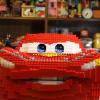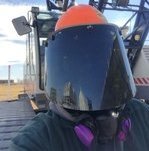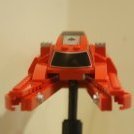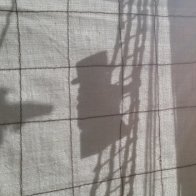Search the Community
Showing results for tags 'chinese'.
Found 12 results
-
Introduction Time for another clone bricks review. No not the Star Wars™ soldiers. Today I am looking at a Chinese clone. Specifically the Kazi M1A2 Abrams main battle tank. While I have seen a few video reviews of it, I could not find any in-depth written reviews of this set. I aim to change that. Set Information Title: M1A2 Abrams Number: KY10000 Released: 2016? Part Count: 1463 Price: Varies Links: Amazon AliExpress Packaging My tank was shipped to me without a box. It took roughly 15 days to process and ship from China to Idaho, USA. The bags and instructions were tightly wrapped in bubble wrap to protect them during shipping. With the exception of the tracks and some larger pieces, all of the bags were numbered. I also received a small bonus sticker sheet, for some reason. There were two instruction booklets, one for the tank, and for for the all-terrain humvee (review coming soon). There is no DSS, as all of the details are printed parts. Instructions The instructions are clear with excellent parts differentiation and directions. Minifigures Five minifigures are included with the set. They are (from left to right): Militia Grenadier Militia AT (Anti-Tank) Gunner? Driver Commander? The Militia grenadier is armed with what appears to be a M32 MGL. The Militia AT is armed with a RPG-7. The gunner has a UMP 9mm with removable(!) suppressor. The driver and commander are unarmed. The figures only have front printing and good articulation. The M1A2 Abrams SEP It is a a very large tank coming in at 27cm long (35cm to tip of barrel), 10cm tall, and 14cm wide. Here it is compared to a Sluban/Oxford tank and the taxi from set 60233 Donut Shop Opening. It absolutely dwarfs the taxi with it's menacing size. The turret spins 360 degrees and the M256 120mm smoothbore gun moves up and down. The turret is also fitted with a small rod to represent the gunner's coaxial M240 machine gun (mounted beside the cannon). The side mounted smoke grenade launchers and commander's independent thermal viewer (the drum-thingy in front of the loader's hatch) are also present. The tank commander has access to a M2 Browning 50 Caliber machine gun while the loader has a LSAT caseless light machine gun mounted over his hatch. (A Brickarms M60 would have been a better choice for the loader's weapon). Unfortunately, the hatches are too small for minifigs to fit in. There are also 4 slightly larger-than-life ammunition boxes for the M2 machine gun mounted on the rear of the turret. The Coalition Identification Panels (the panels with black angles on them) and the battalion markings (F2 panels) are the only printed pieces in the set. Interior The driver's position is well detailed, but there is no way to easily remove/put in said figure without taking apart the front of the tank. The tank does not feature a turret basket, instead it has a space for two minifigures in the middle of the hull. The pair of white tiles are supposed to be data screens/controls. The minifigs can only fit if the are reclining backwards. A small rack of what appears to be SABOT anti-tank shells is also modeled. Behind this is the engine compartment. The gas turbine engine (similar to that of a jet) is well detailed and includes some minor details. I do not particularly like the inclusion of the transparent blue tile, as it seems to clash with the rest of the tank and feels out of place. The only way to open the top engine hatch is to remove the turret. The engine can also be accessed through a pair of doors on the rear of the tank, like the real thing. Exterior Looking at the bottom of the tank, the is no working suspension, even though it is modeled. The tracks roll very smoothly, but only on rough surfaces, like carpet or cloth. Having no suspension, the tank simply rides high over obstacles. How it should actually happen. Here we see a short scene following the crushing of the car. One of the road wheels is swapped for a new one by a repair team. Meanwhile the commander berates the driver for his reckless behavior that damaged the tank. A special forces team provides 360 degree protection throughout the whole process. Not wanting to interrupt the commander, the gunner chats with the leader of the special forces team. With the repairs done, the special forces team escorts the repair crew back to the forward operating base (FOB), while the tank returns to it's original mission. Destroyed Building Included with the set is a destroyed building, in which a pair of militia men have set up an ambush. The building has three floors and looks excellent. A stoplight(?) has been modeled as well as a barrel and signpost. Some TNT and a backpack are provided for the hostile soldiers to presumably use as a makeshift IED. Amusingly, the position of the soldiers will result in the grenadier being back-blasted by the RPG when it is fired. The building has some minor structural details that make it pop and look unique. Summary As far as tank sets are concerned, this set is amazing. It has tons of detail, plenty of playability, and overall good looks. The figures could be better, as well as some of the accessories provided. The mold quality of the parts is rather high, however one of my parts was melted. Do I like the tank? Heck yeah! It is bada** and looks great displayed on my shelf next to it's 1/16th scale brother produced by Tamiya. Would I recommend it? Definitely, as long as you can find it for a reasonable price. Pros Realistically detailed Well made Tons of playability Cons Lack of suspension Odd minifigures Melted piece Score How do I rate this set? Design - 8/10 Looks like the real thing and features plenty of realistic design details Building Experience - 5/10 Not too boring, but not very exciting either. Building the tracks was rather laborious, as expected. Features - 8/10 It has all of the functions that the real tank has and even includes multiple minifigures. Playability - 7/10 I had fun setting up the repair diorama and enjoyed rolling it back and forth when testing the tracks. Parts - 7/10 This set is a decent parts donor with a good variety of unique pieces and accessories Value for Money - Variable I got mine on sale for $35 with free shipping. Your experience may differ. 8/10 - A fantastic replica of the venerable M1A2 Main Battle Tank and good addition to any fighting force. Thank you for reading through my review. C&C are always appreciated and needed, as I am constantly working to improve my review and presentation skills. I leave you now with the view that many Republican Guard tank crews experienced during Operation Desert Storm.
-
Hi everyone! This is my first MOC post, and second post to Eurobricks after my welcome post. I was inspired to make this train from an image on Google of a "CRRC Dalian CKD7B" Chinese locomotive. Apparently these were designed specifically for use in Myanmar, and are very difficult to find any photos of them in the wild! As said in the title, this was inspired by the locomotive- the proportions are a little off! I'm glad with how it came out. Original: http://www.dloco.com/LISTS/product/_MAINPAGE/EProducts/default3.aspx?id=1118 Glad to hear thoughts and comments! Matt
-
Kung Hei Fat Choi!!! Now it is the Year of the Pig, wish all of you a happy and healthy new year. It is a custom for the Chinese people to greet visitors with candies. IMG_4495 by skcheung730, 於 Flickr IMG_4502 by skcheung730, 於 Flickr IMG_4501 by skcheung730, 於 Flickr IMG_4493 by skcheung730, 於 Flickr
-
Hey folks, I post this here mainly because the pirate subforum is the only one I'm really following and as a ship it still fits into the topic. And actually there also were pirates in Asia. I found the two "sails" from the Ewok glider and just had to build a junk with them. So I sat down and tried to build something more stereotypical than accurate, which resulted in following: Hope, you enjoy!
-
It’s been a long time since the Buddhism spread from Indian to worldwide, especially in China. The 1st memory building was named “STUPA” in Indian to memory the Buddha, stored the replics and chanting, mostly it is a tomb of Buddha. When foreigners landed in South China, them were taught the 8 corner tower pronounced “Pagoda”. The word was collected in the dictionary till today, a minus change is to be “Chinese Pagoda” to mean the towers in Asian-Pacific area. Today Chinese people call Pagoda as “Ta” since the word was invented by Ge, Hong in Jin Dynasty. (around AD 300) I selected 6 typical types of Pagoda to be LEGO model, the superstructure of Pagoda can be separated by 3 parts as the picture below: Base, Body, Cha; 1. Basic Stupa The model reflects the main characters of Stupa which is the resource of all pagoda, stupa and etc. Flat base; Hemispherical body; Upside Lotus petal; The “CHA” of tower; 2. Lamaist Stupa The Lamaist stupa was heralded in hemispherical tomb in Fo-kuang Ssu in the latter part of the tenth century. The earliest Lamaist stupa was built in Xizang, China. The model reflects the main characters of Lamaist Stupa Flat and thin base; Higher base (Shu – mi - tso); Aquarius body “Belly” (The variant of hemispherical body); Truncated cone Bottle “Neck” Top “umbrella”; 3. One storied Pagoda The One storied Pagoda may be the 1st culture combined pagoda in Chinese. It mixed the different architecture elements from both Chinese and Indian. It more likes a Chinese pavilion with solid walls and stone or brick roof. The top of body adopts a building technique called “Corbelled brick courses”, they have 2 ways to be shown, positive and negitive. Using the LEGO parts to build this is a real challenge. The picture will show you how. You can also see the “Cha” part is real like the Stupa. 4. Multi-Storied Pagoda I build the 2 storied pagoda only for example. The real Multi-storied Pagoda usually looks similar with the Multi-Eaved Pagoda. The key of distinguish is to see the highest eaves, if they are real close, the pagoda shall be Muti-Eaved, others are Multi-Storied. 5. Bustling Pagoda The bustling pagoda normally use very complex decoration outside, the body sits on a very high Shu – mi – tso. Some pagoda allows people walk inside to the top. 6. Multi-Eaved Pagoda As the name shows, it has several levels of eaves, I built this model in order to show the extreme case, the eaves are very close. I also use a wheel as the “umbrella” part. Through the building progress of these 6 models, you will have a Buddhism trip in Chinese. You can con tact me via jerryyao77@msn.com for the full instructions with a little bucks. Enjoy it! Jerry
-
- architecture
- pagodas
- (and 5 more)
-
Can anyone tell me what do the Asian characters on this part mean? It is a glass piece from Ninjago sets. I am using it on a creation to give to a Japanese teacher, so I would like to confirm what it means before presenting it. Thanks.
- 17 replies
-
- ninjago
- translation
-
(and 2 more)
Tagged with:
-
Hi all, Last month I had build my First Chinese Modular House, Chinese Dim Sum Restaurant. http://www.eurobricks.com/forum/index.php?showtopic=108713 also in LEGO Idea https://ideas.lego.com/projects/101899 Here come the second one, Chinese Modular House #2 ShangHai Bun Restaurant. This building is another type of Chinese style, which is selling Shanghai Bun. Same as last one, full of different details and 4 different outlook in each size. Many Thanks for watching and comments. Outlook Shanghai Bun Restaurant with Chinese Dim Sum Restaurant Different modular Kitchen and a store room at first floor Restaurant at second floor more photo in my flickr album Many thanks for watching
- 24 replies
-
- chinese
- restaurant
-
(and 3 more)
Tagged with:
-
Hi all, lets share my new MOC, Chinese Dim Sum Restaurant. A Chinese style modular house within 4 different surface. a small garden and small temple in left size and a kitchen build by stone in the back. front door a hawker selling some snacks A garden in left size with one table, and a small temple in the corner door open, go inside the kitchen and the Chinese style chef the woman is in cashier 2/F thats the end thanks for watching, also, many photo in my flickr ablum
- 21 replies
-
- chinese
- restaurant
-
(and 3 more)
Tagged with:
-
You may have heard about Chinese lion dance which is a festive activity of the Chinese lunar new year. Indeed, kirin dance is another option, though it is less popular. The LEGO community has also proved this -- perhaps I am the first guy to build this but quite a number have built lion dance (according to google ^^). For your informaton, kirin is a mythical creature. Asian people believe it can wipe out evil spirits and bring lucks. After all, [though you may not be Asians] happy lunar new year and wish you joyful and healthy all the time! Cheer!
-

Chinese New Year 2014 - Year of the Horse and Chinese Character
concuzz posted a topic in Special LEGO Themes
Happy Chinese New Year everyone! The challenge here was to create the smallest possible horse with poseable legs, and the simplest way to convey the grace of the traditional Chinese character for horse. More festive creations to come! www.facebook.com/bricksbencreations www.flickr.com/photos/bricksben www.bricksben.com -

(Chinese New Year-related MOC) Lucky Banner and Candy Box
skcheung posted a topic in Special LEGO Themes
This is a challenging task to me -- to explain what is Chinese New Year to non-Chinese. To put it in short, the Chinese New Year in 2014 starts on January 31. It is the Year of the Horse. (For your reference, 12 animals take turn to represent a particular year.) Chinese people would like to hang red banner, with words of luck/ fortune/ etc, on walls. I am no exception but I rather make it with LEGO but not ordinary paper... The Chinese character is "LUCK" in English. Another custom is the presentation of a candy box. Chinese New Year is a big festival and it is a high time for children to take as many candies as they wish. The Chinese character on the cover of the candy box is "HORSE" in English. Before I place candies into the box, instead I put some pearl gold bricks in the middle. Chinese people would hope to make a big fortune in the coming year and so they would like to see gold elsewhere in this festival. In the meantime, I also put 4 LEGO tangerines. In the Chinese language, the word "tangerine" sounds the same as "luck". Thank you for watching. Wish everyone healthy and fruitful in the coming year!!! -
Hi all, Here bring my new work. Chinese traditional Residental area, Small Siheyuan, Beijing style. More information about Siheyuan http://en.m.wikipedia.org/wiki/Siheyuan A siheyuan is a historical type of residence that was commonly found throughout China, most famously in Beijing. In English, siheyuan are sometimes referred to as Chinese quadrangles. The name literally means a courtyard surrounded by four buildings. Throughout Chinese history, the siheyuan composition was the basic pattern used for residences, palaces, temples, monasteries, family businesses and government offices. In ancient times, a spacious siheyuan would be occupied by a single, usually large and extended family, signifying wealth and prosperity. Today, many remaining siheyuan are still used as housing complexes, but many lack modern amenities.]here is a screen wall inside the gate, for privacy; superstition holds that it also protects the house from evil spirit A pair of stone lions are often placed outside the gate. .Thanks for your watching.[/font]





